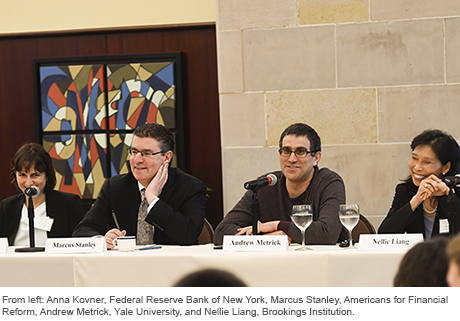The Role of Central Bank Lending Facilities in Monetary Policy

Central bank lending facilities were vital during the financial crisis of 2007-08 when many banks and nonbank financial institutions turned to them to meet funding needs as private funding dried up. Since then, there has been renewed interest in the design of central bank lending facilities in the post-crisis period.
Market Liquidity after the Financial Crisis
Low Productivity Growth: The Capital Formation Link

A major economic concern is the ongoing sluggishness in the growth of output per worker hour, generally called labor productivity. In an arithmetic sense, the growth of the economy can be accounted for by the increase in hours worked plus that of labor productivity. With the unemployment rate now at a level widely regarded as near “full employment,” growth in hours worked is likely to be limited by demographic forces, most importantly the very limited expansion of the working-age population. If productivity growth also remains low, the sustainable pace of increase of real GDP will be limited and remain noticeably lower than historic norms.
At the New York Fed: Twelfth Annual Joint Conference with NYU‑Stern on Financial Intermediation

Anyone who has a savings account, has taken out a mortgage, or has been part of a business seeking new capital has relied on the smooth functioning of the institutions and markets that collectively perform financial intermediation. Because financial intermediation is so critical to the functioning of a modern economy, it is important to understand its inner workings—its fundamental features, recent innovations, and lines of transmission to real economy activity, as well as its imperfections and its interactions with regulatory policies. As part of an ongoing effort to foster such an understanding, the Federal Reserve Bank of New York recently hosted the twelfth annual Federal Reserve Bank of New York–New York University, Stern School of Business Conference on Financial Intermediation. In this post, we explore some of the discussions and findings from the May 10 conference, which focused on recent advances in the study of financial intermediation.
Low Interest Rates and Bank Profits
Introducing the Revised Broad Treasuries Financing Rate

The Federal Reserve Bank of New York in cooperation with the Office of Financial Research is proposing to publish three new overnight Treasury repurchase (repo) benchmark rates. Recently, the Federal Reserve decided to modify the construction of the broadest proposed benchmark rate (the other two proposed rates are expected to remain unchanged; see the Bank’s announcement on May 24). In this post, we describe the changes to this rate in further detail. We compare this revised rate to the originally proposed benchmark rate and show that, in the post-liftoff period, it trades higher, on average.
Hey, Economist! How Do You Forecast the Present?

New York Fed macroeconomists have been sharing their “nowcast” of GDP growth on the Bank’s public website since April 2016. Now, they’ve launched an interactive version of the Nowcasting Report, which updates the point forecast each week, but also helps users better visualize the impact of the flow of incoming data on the estimate produced by the model. Tables offer more detail on the data series informing the estimate. The interactive version also reports the staff nowcast back to January 2016, a longer nowcast history than has previously been available. Cross-media editor Anna Snider spoke to Domenico Giannone, Argia Sbordone, and Andrea Tambalotti—economists who developed the model underlying the report and produce estimates weekly with the help of research analysts Brandyn Bok and Daniele Caratelli—about nowcasting and its role in the policymaking process.
Just Released: June Regional Business Surveys Paint a Mixed Picture

Yesterday’s June Empire State Manufacturing Survey pointed to a significant increase in regional manufacturing activity. However, our parallel survey for the region’s service sector, the June Business Leaders Survey, released today, paints a somewhat dreary picture of regional service-sector activity. These two surveys, taken together, suggest that economic conditions in the New York-Northern New Jersey region are mixed.
Valuing Workplace Benefits

Workplace benefits—such as parental leave, sick leave, and flexible work arrangements—are increasingly being recognized as important determinants of differences in labor supply behavior, education and occupation choice, inequality in wages, and gender disparities in labor market outcomes.
Just Released: Bank Loan Performance Under the Magnifying Glass

The New York Fed’s recently released Quarterly Trends for Consolidated U.S. Banking Organizations (QT report) confirms that bank loan portfolios look a lot healthier than they did just a few years ago, reflecting the sustained economic recovery from the Great Recession. In this post, we sharpen the focus to look at bank loan performance in more detail, using more disaggregated charts added to the QT report this quarter.












 RSS Feed
RSS Feed Follow Liberty Street Economics
Follow Liberty Street Economics